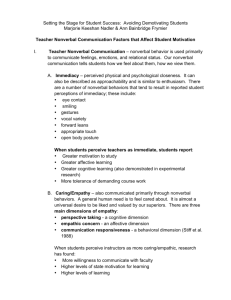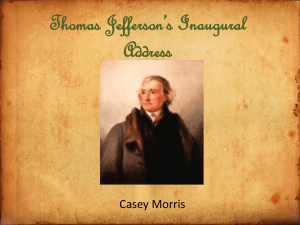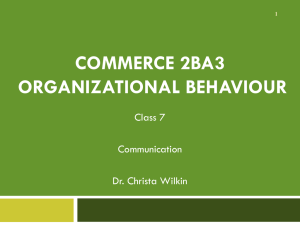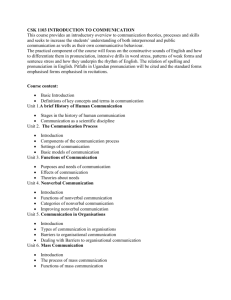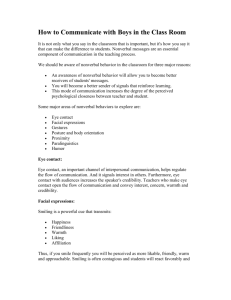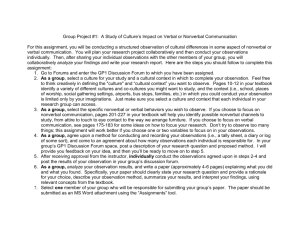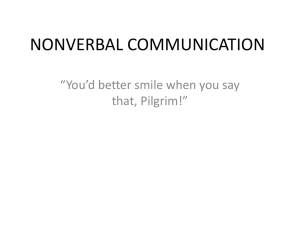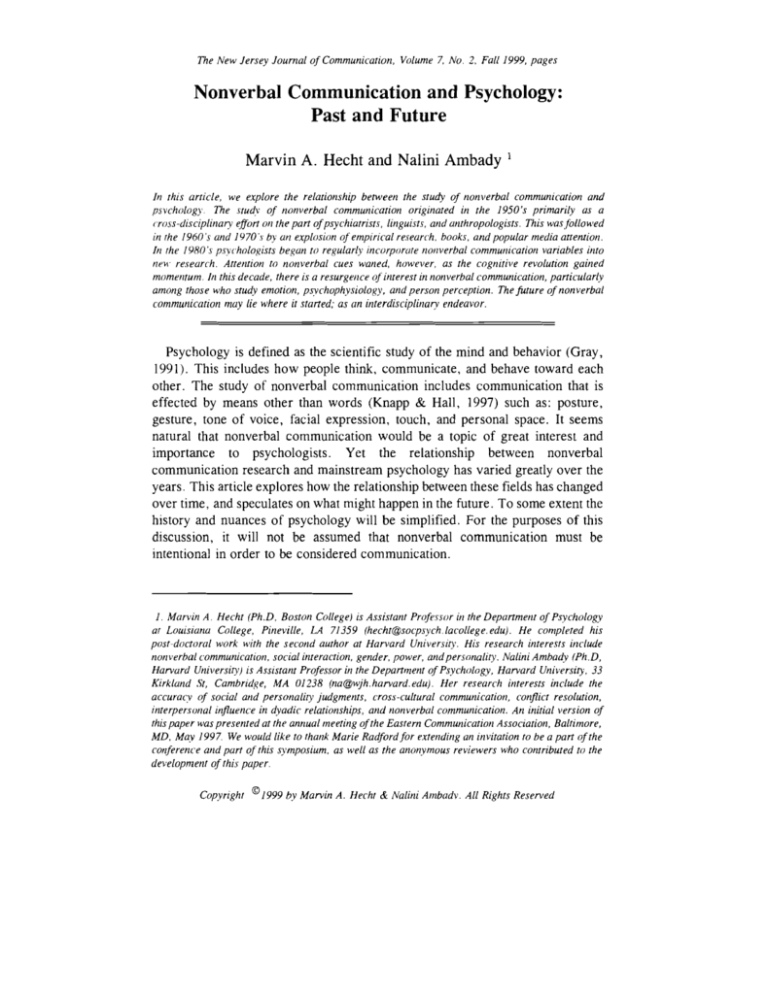
The New Jersey Journal of Communication, Volume 7, No. 2. Fall 1999, pages
Nonverbal Communication and Psychology:
Past and Future
Marvin A. Hecht and Nalini Ambady
'
In this article, we explore the relariot~ship between the srudy of nonverbal communication and
psvchology. The stu@ of nonverbal communication originated in the 1950's primarily as a
c.ross-disciplinaty effort on ?hepart of psychiatrist.^, linguists, and unrhropologists. This wasfollon~ed
in rhe 1960's and 1970's by an explosion of empirical re.rearch. hooks, and popular media anemion.
Itr rhe 1980's p.syr~hologistsbegan to regularly incorporcrre nonverbal communication variables into
nrM. research. Attetuiotr to nonverbal cues waned, however, as the cogt~iriverevolurion gained
momenrutn. It1 this decade, there is a resurgence of inrerest in nonverbal communication, particularly
among those who srudy emotion, ps,vchophysiology, and person perceprion. The future of nonverbal
communication may lie where ir started; as an interdisciplinaty endeavor.
Psychology is defined as the scientific study of the mind and behavior (Gray,
1991). This includes how people think, communicate, and behave toward each
other. The study of nonverbal communication includes communication that is
effected by means other than words (Knapp & Hall, 1997) such as: posture,
gesture, tone of voice, facial expression, touch, and personal space. It seems
natural that nonverbal communication would be a topic of great interest and
importance to psychologists. Yet the relationship between nonverbal
communication research and mainstream psychology has varied greatly over the
years. This article explores how the relationship between these fields has changed
over time, and speculates on what might happen in the future. To some extent the
history and nuances of psychology will be simplified. For the purposes of this
discussion, it will not be assumed that nonverbal communication must be
intentiona! in order to be considered communication.
1 . Marvin A. Hecht (Ph.D, Boston College) is Assistant Professor in the Department of Psychology
ar Louisiana College, Pineville, LA 71359 (hecht@socpsych.lacollege.edu). He conlpleted his
post-doctoral work with the second author at Harvard University. His research interests include
nonverbal communicatiotl, social interaction, gender, power, andpersonality. Nalini Ambady lPh.D,
Harvard University) is Assisrant Professor in the Departrrzent of Psychology, Harvard Universip, 33
Kirkland St, Cambridee, M A 01238 (na@wih.harvard.eduJ. Her research interests include the
accurac,v r,f social and personality judgments, cross-cultural communication, conflict resolution,
interpersonal influence in dyadic relationships, and nonverbal communication. An initial version of
this paper was piesenred at the annual meeting of the Eastern Communicariot~Association, ~altimore,
M D , May 1997. We would like to thank Marie Radford for e-rrending an invitation to be a part of the
conference and part ofthis symposium, as well as the anonymous reviewers who conrributed to the
development of this paper.
Copyright ' 1 9 9 9 by Marvin A . Hechr & Nalini Anzbadv. All Rights Reserved
2 Marvin A. Hecht and Nalini Ambady
Antecedents of the Psychological Study of Nonverbal Communication
The father of modern psychology is generally seen as William James who, in
1890, published a book called the Principles of Psychology (James, 1890). It is
interesting that this early textbook contained a great deal of theory about emotion
that was not fully explored until much later (see Arkin, 1990). Instead, early work
in experimental psychology explored such phenomena as object perception, the
flow of consciousness, and learning processes. Some early thoughts about
nonverbal communication also came from Charles Darwin who, in 1872,
published The Expression of the Emotions in Man and Animals (Darwin, 1872).
This was one of Darwin's less successful books in terms of its quality and
ultimate impact on the field (Fridlund, 1994). Still, the ideas in this book
regarding emotional expression and nonverbal behavior were intriguing and were
not fully explored until many years later (see Ekman, 1973).
While the foundations for the study of nonverbal communication in psychology
were laid in the late 1800s in James' and Darwin's work, these ideas remained
dormant for some time while psychology became fascinated with behaviorism.
Behaviorism. emphasizing the study of overt behavior and learning, became
prominent in the 1920s through its proponents John B. Watson and then later in
the 1940s and 1950s by B. F. Skinner. But behaviorism never touched on human
nonverbal behavior, for two reasons. First it involved the study of behavior at a
more general level of abstraction (actions, goals, and rewards) than the more
molecular cues studies in nonverbal communication. Second, it was thought that
the principles of learning and behavior were best examined in lower animals such
as rats and pigeons, and studies of humans were relatively rare.
While psychologists were exploring behaviorist principles, the study of
nonverbal communication was begun in 1955 by a group of interpersonal
psychiatrists, structural linguists and anthropologists who met in Palo Alto to
jointly analyze a film. The group included Adam Kendon, Albert Scheflen, and
Ray Birdwhistell (Leeds-Hurwitz, 1987, as cited in Kendon, 1990). Their joint
expertise led to an analytic method called context analysis, in which all observed
behaviors are transcribed in excruciating detail onto a coding sheet that resembles
a musical score. Context analysis was later used to study such events as the
structure and sequence of human greetings, social behavior at an outdoor party,
and the function of posture during family therapy.
A Time of Research
The mid-1960's saw an explosion of research in many areas of nonverbal
communication. For instance, Argyle and Dean (1965) studied eye contact and
The New Jersey Journal of Cornrnlmication, Volume 7, No. 2, Fall 1999
Nonverbal Cott~tt~unication
and Psychology: Past and Future 3
how it related to conversational distance. Exline and his colleagues examined
patterns of looking while speaking and looking while listening (Exline, Gray, &
Schuette, 1965). Hess produced several interesting studies on pupil dilation
published in Scientific American (Hess, 1975). Sommer ( 1969) studied the
environment and personal space. Rosenthal (1967) discovered that expectations
made by teachers and researchers can influence their outcomes, and that subtle
nonverbal cues may play an important role in this process. Mehrabian (1969)
studied the nonverbal cues of liking and immediacy.
During this initial period of research there was a great deal of excitement
regarding the power of nonverbal cues. Early empirical work was geared to
making the argument that nonverbal behavior should not be ignored. Many studies
were published which demonstrated that nonverbal communication affected
people's reactions, since this was an important message in and of itself at the
time. However in the rush to collect data, an important element had been left out.
Theoretical models and/or integrative studies were relatively rare, leaving a large
body of interesting but seemingly unrelated information.
By the 1970's a number of scholarly volumes in psychology appeared
summarizing the growing body of research, such as Weitz's (1979) Nonverbal
Communication and LaFrance & Mayo's (1978) Moving Bodies. The Journal of
Environmental Psychology and Nonverbal Behavior (now Journal of Nonverbal
Behavior) was also founded in 1978. At around the same time, the general public
seemed to take a strong interest in nonverbal communication as well. Journalists
wrote a number of popular books on nonverbal communication (Koivumaki,
1975). A report in the New York Times describing the work of the early pioneers
evolved into a book (Davis, 1973). Other popular books included Body Language
(Fast. 1970) which focused on how to use nonverbal communication to attract
other people, and How to Read a Person Like a Book (Nierenberg & Calero,
1971) which examined nonverbal behavior in negotiation situations.
Ironically, while the popularity of these books did much to increase public
awareness, they may have delayed the acceptance of the initial wave of nonverbal
communication research for the rest of the psychological community. Popular
books vastly oversimplified the research findings, going way beyond what could
be accurately concluded (Koivumaki, 1975). This led to bogus statements and
recommendations, such as the idea that people who fold their arms across their
chest are closed-minded, or the idea that people who unzip their jackets are
literally opening up (Nierenberg & Calero, 1971). Another false idea was that one
can manipulate one's own body language to influence others to make others more
attracted without their realizing it (Fast, 1970). Research since then has found that
context matters a great deal when interpreting any one nonverbal gesture
The New Jer.\ry Journal of Commutnc~ufiot~.
Volume 7.No 2, Full 1999
4 Marvin A. Hecht and Nalir~iAmbady
(LaFrance & Mayo, 1978) and that consciously manipulating nonverbal cues can
often backfire (Ekman, 1985).
In this time of heightened popularity of nonverbal communication, it became
increasingly difficult to be considered a "serious" researcher while studying
nonverbal communication. Another obstacle came soon afterwards: the cognitive
revolution.
The Cognitive Revolution and its Impact
In the late 1970s and early 1980s, coinciding with the event of developments
in computer and information processing technology, psychologists began to
construct models of behavior using an information processing metaphor. The
cognitive revolution affected all areas of psychology, no1 just the study of brain
(Gardner, 1985). In 1980, the Journal of Personality and Social Psychology
named a new section of its journal Attitudes and Social Cognition. A new journal,
Social Cognition, was founded in 1982. The focus shifted from behavior to
thoughts and internal processes. People were no longer seen as actively behaving
or operating on their environment. Instead, they were viewed as epistemologists
who actively constructed their environment, made attributions, and searched for
causal relations (Ross & Nisbett. 1991).
Coinciding with this paradigm shift, for many areas of psychology there was
a shift away from questions about when a particular phenomenon happened, to
how and why it happened. For example, researchers studying helping behavior
shifted away from studying various conditions under which people help (a when
question) to studying what factors motivate helping, egoism or altruism (a why
question). Attitude researchers turned away from studying the conditions
necessary for holding a certain attitude to examining why attitudes are important
in terms of the functions they serve. In methodological terms, there was a shift
away from studying variables that moderated an effect to discovering the
underlying mediating or causal variables (Baron & Kemy, 1986).
In the midst of this new emphasis on causes and processes, the emerging field
of nonverbal communication was again dealt a setback. Questions of a causal
nature require a theoretical model as a basis.
There were some theories in nonverbal communication, such as Argyle and
Dean's (1 965) intimacy equilibrium model, and Henley 's (1977) theory that social
power was the motivation underlying particular nonverbal behaviors. However,
neither of these theories was able to serve as a comprehensive model for
predicting or explaining nonverbal behavior. As a result, the study of nonverbal
communication was swept aside as the cognitive revolution gained momentum.
Another reason that nonverbal communication may have been left out of the
cognitive revolution was due to the notion that nonverbal communication is
The New Jersey Journal of Communication, Volume 7, No. 2, Fall 1999
Nonverbal Communicutiotz urld Psychology: Past and Future 5
relatively automatic, not requiring thought. It became difficult to tie a supposedly
thoughtless process to a paradigm that was concerned primarily with thinking.
The fact that certain nonverbal cues may stimulate thinking was not pursued in
psychology either. While presently there is a renewed interest among cognitive
psychologists toward examining unconscious and automatic processes (Cohen &
Schooler, 1997; Uleman & Bargh, 1989) which bodes well for the study of
nonverbal communication, at the time there did not seem to be a good fit between
the fields.
The cognitive revolution continues today as it evolves in the form of sub-fields
within separate disciplines in psychology (e.g., cognitive development, animal
cognition, social cognition). Many jobs in social psychology are being
re-configured as jobs in social cognition, and some universities (such as the
Massachusetts Institute of Technology) have a department of cognitive science but
no longer a psychology department. A number of psychologists who studied
nonverbal communication full-time in the 1960s or 1970s have since shifted to
focus more on social cognition in their research, or they have dropped their
nonverbal communication research entirely. Thus the amount of research focusing
exclusively on nonverbal communication has remained relatively flat since the
1970s. One consequence of this is that while the Journal of Nonverbal Behavior
has been able to maintain its initial publication rate of four issues a year, it has
not undergone a major expansion.
There is still cause for hope, however. In the remaining sections, reasons for
optimism about the psychological study of nonverbal communication in the next
millennium will be discussed.
The Future of Nonverbal Communication and Psychology
The first cause for optimism is that the pioneering work on nonverbal
communication made it acceptable to include nonverbal variables in psychological
study as a dependent or independent measure. For example, researchers who
study topics such as empathy, expectancies, or deception now regularly examine
nonverbal cues. Even areas of psychology that have traditionally not looked at
nonverbal cues (e.g., the study of attitudes) now include nonverbal
communication in their experiments (e.g., Hrubes, & Feldman, 1997; Marsh,
Hart-O'Rourke, & Julka, 1997). Thus the number of nonverbal studies in
premiere psychology journals is increasing (Hall, 1992). For example, recent
studies in the Journal of Personality and Social Psychology include smiling and
Olympic athletes (Fernandez-Dols, & Ruiz-Belda, 1995), touching as a function
of hierarchy (Hall & Veccia, 1990). and judged and behavioral coordination
(Capella, 1997). Today many researchers are studying nonverbal communication
The New Jersey Journal of'Communication, Volume 7, No. 2, Fall 1999
6 Marvin A. Hechr and Nalini Ambady
as one facet of a larger human dynamic, such as power, deception, anxiety, or
prejudice. As a result of the increased recognition of nonverbal behavior, for the
first time there is a chapter on nonverbal communication in the current edition of
the Handbook of Social Psychology (DePaulo & Friedman, 1998).
It is also interesting to examine which journals are leading this trend. Certain
psychological journals seem to include more nonverbal studies than others. To
examine this trend, journal titles were analyzed and coded for the number of
articles on nonverbal communication they contained. The journal titles were
derived from an extensive literature review conducted as part of two large
meta-analyses, one on gender differences in smiling (LaFrance, Hecht, & Noyes,
1994), and one on immediacy cues and liking (Tickle-Degnen, Hecht, Harrigan,
Ambady, & Rosenthal, 1997). References were also included from a review of
touching research by Stier & Hall (1984). Finally, every journal reference from
the new chapter on nonverbal communication in the Handbook of Social
Psychology (DePaulo & Friedman, 1998) was coded. This collection of citations,
therefore, includes almost every aspect of nonverbal behavior, and while it is not
a random sample, it does provide an approximate idea of which journals have the
most nonverbal content. In the above meta-analyses and reviews, the search was
not restricted to psychology journals, but included other fields such as
communication and medicine.
Table 1 shows the journals listed in descending order in terms of frequency of
nonverbal articles. Journals that were represented only once or twice are not
listed. Overall, the table indicates that nonverbal communication is studied in a
wide variety of fields, nationally as well as internationally. It was expected that
the Journal of Nonverbal Behalior would be near the top (it is second) because
by definition all studies have to do with some aspect of nonverbal communication.
What is really striking is the number of nonverbal articles in the sample from the
Journal gf Personality and Social Psychology, widely considered to be the
premiere journal in the field of social psychology. The number of articles from
this monthly journal exceeds the Journal of Nonverbal Behalior, which is only
published quarterly. Other psychology journals with frequent nonverbal studies
are Personality and Social Psychology Bullerin (the nexl most prestigious journal
in social psychology), Journal of Counseling Psychology, and several other
developmental, gender, and personality related journals. In the field of
communication, the journals that most frequently publish articles on nonverbal
communication include Human Communicarion Research and Communication
Monographs. On the whole, the table shows that there are a wide variety of
journals that publish nonverbal articles. This was not the case in the early 1960s
before the field became popular.
The New Jerse! Jourrlal c$Cc~mmunication, Volume 7, No. 2, Fall 1999
Non~~erbal
Communicorion and Psychology.. Pasr and Future 7
Table 1
Frequency of Nonverbal Articles in Selected Journals (Please Give Dale Ranges)
Journal Name
Frequency
Journal of Personality and Social Psychology
Journal of Nonverbal Behavior
Personality and Social Psychology Bulletin
Journal of Counseling Psychology
Child Developmenr
Hummt Communicarion Research
Developmenrul Psychology
Journal of Personality
Sex Roles
Journal of Experimental Social Psychology
Journal of Consulring and Clinical Psychology
Journal of Social Psychology
Perceprual and Moror Skills
Commun~catronMonographs
Jollrnul of Applied Social Psychology
Britlsh Journal of Social and Clinical Psycholoy~
Journal of Research in Personality
Psychiarty
European Journal of Social Psychology
Jo~trnalof Applied Psychology
Journal of Social and Personal Relarionships
Psychological Reports
Represenfarive Research in Social Psychology
Social Psychology Quarterly
Inrernarional Journul of Psychology
Journal of Communicarion
Japanese Psychological Research
The second cause for optimism is that in addition to the fact that nonverbal
communication is being re-integrated into many areas of psychology, there has
also been a re-emergence of certain fields that are inherently nonverbal in their
focus: emotion, psychophysiology, and person perception. Each of these are
discussed in turn.
First, research on emotion is becoming very popular. Attitudinal researchers
and social cognitive psychologists now recognize that many thoughts are
affect-laden, and therefore emotion is an important variable to study. Some
eminent researchers who have been working in the emotion field for years have
finally begun to be recognized. For example, Paul Ekrnan recently won a lifetime
contribution award from the American Psychological Association. There have also
been special issues on emotion in mainstream journals (e.g., Arkin, 1990) and
tributes to Darwin (Ekman, 1973). There is an active journal entitled Motivation
and Emotion that is well respected in the field of emotion, and the American
The New Jersey Journal of Conrmunicarion. Volume 7, No. 2, Fall 1999
8 Marvin A. Hechr and Nalini Ambady
Psychological Association has announced a new journal entitled Emotion. Recent
books and chapters on emotion also summarize work on emotional intelligence
(Coleman, 1995; Mayer & Salovey, 1997) and emotional contagion (Hatfield,
Cacioppo, & Rapson, 1994).
Another emerging field that employs nonverbal cues is the field of social
psychophysiology (Blascovich, 1990; Cacioppo & Petty, 1983). A typical study
examines how fine-grained physiological measures such as heart rate and skin
conductance vary in different social situations. Part of the battery of physiological
measures collected in a typical study include traditional nonverbal cues such as
smiling and nodding. Other measures, such as facial EMG (Fridlund, 1991), lie
at the boundary between "internal" physiological responses and "external"
nonverbal cues. Social psychophysiology is also used to study interpersonal
relationships, including patterns of negative affect reciprocity in marriage
(Levenson, & Gottman, 1983) and how these patterns effect the likelihood of
divorce (Markman, 1981).
Lastly, personality researchers, who study the accuracy of person perception,
are increasingly looking to nonverbal cues as potential moderators of accuracy.
In a typical study, participants observe another person for a short period of time,
and then make ratings of that person (Kenny, 1994). The goal is to see whether
naive judges can accurately evaluate the personality of another person under
various conditions. Research has shown that people are indeed accurate at greater
than chance levels at detecting other's thoughts and feelings (Ambady &
Rosenthal, 1993; Borkenau & Liebler, 1992; Snodgrass, Hecht, Ploutz-Snyder,
1998). As part of this type of study, researchers often code specific nonverbal
cues to examine what accounts for the accuracy. For example, in a study of
teachers (Ambady & Rosenthal, 1993). it was found that one variable that was
significantly predictive of positive teaching evaluations was frequent gesturing.
Some Reservations About the Future
While all of the recent attention on psychology and nonverbal communication
seems encouraging, at the same time there are some aspects of the present
resurgence that leave some reservations. First, as a consequence of the focus on
integrating nonverbal behavior with the particular psychological dynamic being
studied, the number of psychologists studying nonverbal communication as a topic
on its own has decreased greatly since the 1970s. Today, very few psychologists
focus exclusively on nonverbal communication. Most psychologists who study
nonverbal communication today are known primarily as health psychologists,
emotion researchers, gender researchers, personality psychologists, etc. It could
be argued that nonverbal communication should only be studied within a
The New Jersey Journal of Communication, Volurrie 7, No. 2, Fall 1999
Nonverbal Communication and Psychology.. Past and Future 9
particular domain--but the splintering across domains may be holding back the
development of an integrated theory of nonverbal communication.
Another potential problem with the re-emergence of nonverbal research in
emotion and psychophysiology in particular has to do with some underlying
assumptions of research on emotion. For example, emotion researchers examine
nonverbal cues from the perspective that they represent external manifestations
of people's internal affective state (Ekman, 1992). From this perspective, the
function of smiling is to express pleasure or happiness. The contrasting
perspective is that facial expressions stem from social and interpersonal needs,
and evolved to serve more of an interpersonal communicative function than an
expressive one (Fridlund, 1994). This debate has produced some of the most
interesting and creative classic experiments in psychology to date. Two
experiments, both published in the Journal of Personulit)! and Social Psychology,
are worth describing into more detail (Fridlund. 1991; Kraut & Johnston, 1979).
Kraut and Johnston (1979) wanted to test whether smiles were more associated
with emotion or with sociality. They conducted their study at a local bowling
alley. They reasoned that if the emotional hypothesis were true, then bowlers who
get a strike should start smiling as they see the ball knocking over the pins. On
the other hand, if the sociality hypothesis were true, then bowlers would not start
smiling until they turned around to face their friends. One observer was stationed
at the end of the bowling line inside the pin setting equipment, while another
observer sat behind the pit containing the bowler's friends. The results showed
strong support for the sociality hypothesis. Across 116 observations, bowlers
smiled 36 times while facing their friends, and only 4 times while facing the pins
(Kraut & Johnston, 1979). Smiling was also unrelated to performance. Only one
of the 4 smiles was after a good score, even though bowlers rolled a total of 26
strikes or spares. Kraut and Johnston (1979) concluded that smiling is more of a
social act than an emotional one. They also conducted several follow-up
experiments by conducting naturalistic observations of groups of people at Cornell
hockey games, and of passersby in downtown Ithaca. Results showed that smiling
could be predicted better by the presence of other people than by factors such as
whether the team was winning or whether it was a sunny day or not.
Fridlund (1991) also conducted a now classic experiment on the sociality of
smiling. At the time, most previous research on emotion used a methodology
whereby people were shown emotion-provoking films while alone in a room,
based on the idea that the resulting expressions would be relatively pure and free
of external and social influences. Fridlund set up four experimental conditions
which varied in their sociality. In all conditions, the participant watched a film
designed to elicit pleasant feelings (puppies, babies, and sea otters playing, as
well as a Steve Martin comedy sketch from Saturday Night Live). In the first,
non-social condition, participants watched the film alone in a room (similar to
The New Jersey Journal of Conununicution, Volun~e7, No. 2, Fall 1999
10 Manin A. Hechr and Nalini Ambady
other emotion experiments). In another condition, participants watched the same
film while a friend they had brought with them filled out some questionnaires in
an adjacent room. In the third condition, the friend watched the same film as the
participant, but in an adjacent room. Finally, in the most social condition, the
friend watched the film in the same room with the participant. This was the only
condition where the friends were actually together in the same room and was
considered the most social condition.
The results of this study are fascinating. Fridlund (1991) found that smiling (as
measured by Facial EMG) increased linearly as the sociality of the situation
increased. That is, even though in three of the conditions, participants were
actually alone, their level of smiling corresponded to the "psychological
closeness" of their friend. Participants smiled more when their friend was filling
out questionnaires than when no friend was present, and they smiled even more
when they thought their friend was watching the same film next door. Participants
smiled the most when the friend was actually in the same room with them.
Moreover, this increased smiling was not due to happiness, which remained
constan: across the four conditions. Fridlund concluded that people smile readily
in response to the presence of real or imagined others, and that even solitary
facial behavior is not necessarily a result of emotion alone.
Fridlund's study did not distinguish between genuine and non-genuine smiles.
Elsewhere, Ekman (1992) has demonstrated that smiles of genuine enjoyment
involve not only the muscle which pulls the lip corners upward (zygomaticus
major) but also the muscle circumferencing the eyes (orbicularis ocularis),
producing crow-feet wrinkles at its the outer edges. Had Fridlund measured the
orbicularis ocularis muscle as well. he might have found that genuine smiles were
related to happiness. Perhaps it was primarily the non-genuine smiles then that
varied with the sociality of the situation.
Other experiments will no doubt attempt to further delineate emotional and
social motivations for nonverbal behavior. In the mean time, more experiments
are needed which focus not just on sociality in general, but on particular social
roles and relationships. For example, Hecht & LaFrance (1988) examined how
being in a powerful role may give one the license to smile when happy or not
smile if one does not feel happy. Psychiatrist Albert Scheflen also considered
nonverbal cues important in social interaction, but many of these ideas remain
empirically untested. For example. while Scheflen's work on postural mirroring
and rapport (Scheflen, 1964) has been widely explored in the last 30 years
(LaFrance, 1985; Capella, 1997; Bernieri & Rosenthal, 1991), his ideas about the
role of nonverbal signals in initiating courtship (Scheflen, 1967) and in
maintaining the social order (Scheflen, 1972) have been left relatively unexplored.
Further, despite the recent advances in nonverbal communication research,
most introductory psychology textbooks ignore nonverbal communication. Some
The New Jersey Journal
of Cortr~nut~icutiot~.
Volume 7, Nu.
2. Fall 1999
Nonverbul Cotii~nunrtat~on
and Pcichologv Past and Future 11
texts include a small section or box on nonverbal communication, but the
placement seems to be haphazard--sometimes it appears in the emotion section
(e.g., Hockenbury & Hockenbury, 1997), the social behavior section (e.g.,
Gleitman, 1996), the language section (e.g., Bernstein, Clarke-Stewart, Roy, &
Wickens, 1997), or some other section.
Concluding Thoughts
In summary, it appears that the link between psychology and nonverbal
communication has varied greatly over time. Currently, there is a resurgence of
interesr, and major journals are publishing nonverbal communication research by
psychologists. However. only time will tell if this new interest continues, and
whether both intrapersonal (emotional) and interpersonal (social) aspects of
nonverbal communication will be studied. There is also an urgent need for more
theoretical integration in the field. There is still no generally accepted theoretical
model for explaining or predicting nonverbal communication. Psychologists
sometimes look to Brunswick's (1956) lens model of interpersonal perception, but
this model is not limited to nonverbal communication. Patterson's (1983)
functional analysis was able to integrate a large number of nonverbal studies post
hoc, but this model is not currently being used as a predictive tool.
As a whole, psychologist have not written many of textbooks on nonverbal
communication. With some exceptions (Knapp & Hall, 1997; LaFrance & Mayo,
1978), the majority of textbooks are written exclusively by communication
scholars (see, Burgoon, Buller, & Woodall, 1996; Hickson & Stacks, 1993;
Leathers, 1996; Malandro, Barker, & Barker, 1989; Richmond, McCroskey, &
Payne, 1995). Ironically, it may be that the future of nonverbal communication
lies in the same arena as it started: as an interdisciplinary endeavor. Resources
may need to be consolidated more to keep the field active and moving ahead;
indeed this is a major reason for choosing to include this paper as part of this
symposium--to promote cross-fertilization between fields. The previous review
of publications indicates that articles about nonverbal communication appear
regularly in both psychological and communication journals. Yet, for the most
part, academics from both fields read and publish almost exclusively within their
own discipline, leading the creation of parallel but non-overlapping tracks of
research (Hall, personal communication, 1992). Psychologists may want to
publish in Human Communication Research. and communication scholars may
want to publish in the Journal of Personalip and Social Psychology. To a small
extent, this has already been happening (e.g., Cappella, 1997) but probably not
at the level that one might expect given the similarity of overlap that exist between
the two fields.
The New Jersev Journal of Conmlunicarion, Volume 7, No. 2, Fall 1999
12 Marvin A. Hechr and Nalini Atnbady
Being aware of each other's fields may also help to integrate theoretical
findings. It would be futile in this short space to attempt to integrate psychological
and communication theories, but a recent study may represent a step in the right
direclion. Manusov (1992) published a paper in Communication Quarterly which
examined nonverbal synchrony and attributions, the latter being a topic of interest
to social cognitive psychologists. Manusov (1992) had a confederate mimic a
participant's posture during a social interaction, to evaluate whether this would
increase liking, and in general it did. But then Manusov went a step further and
examined the attributions participants made. If participants assumed that the
mimicry was somewhat intentional, they mostly regarded the partner favorably
and the synchrony as meaningful, but if it was seen as completely deliberate then
participants experienced a negative reaction toward the confederate, claiming to
be manipuIated. This experiment is significant because it attempts to relate the
nonverbal synchrony literature to social cognition.
In addition to reading and publishing in each other's journals, it may be useful
to join the various professional organizations. For psychologists, the two main
ones are the American Psychological Association (http://www.apa.org), and the
American Psychological Society (http://www.psychologicalscience.org). The
former is somewhat more clinically oriented while the latter is more geared to
research. Organizations at the regional level include the Eastern, Midwestern,
Southeastern. Southwestern, and Western Psychological Associations, as well as
the New England Psychological Association and the Rocky Mountain
Psychological Association. In communication, the major organizations include the
International Communication Association and the National Communication
Association. Regional associations include the Eastern and Western
Communication Associations, and the Central States, Western States, and
Southern States Communication Associations.
By saying that more interaction is needed is not to imply that psychologists and
communication scholars don't have slightly different and unique approaches.
Psychologists sometimes accuse communication scholars of not having enough
theory. However, too often psychologists do not hold their theories lightly enough
(Rosnow & Rosenthal, 1997), trying too hard to shoehorn their data to fit the
mold of a particular theory. Psychologists tend to emphasize quantitative studies
over qualitative studies but this too may be changing. Researchers in bolh fields
need to recognize their differences and to realize that approaches can be
complementary. There is too much work left to do in nonverbaI communication
for psychologists and communication scholars not to work together jointly.
The New Jersey Joltrnal of Cotnrntct~icurion.Volutiir 7, No. 2, Full 1999
Nonverbal Communication utrd P\i c,hology; Past and Future
I3
References
Ambady, N.. & Rosenthal. R. (1993). Half a minute: Predlcring ~eiicherevaluations from thin
slices of nonverbal behavlor and physlcal attractiveness. Jounlul of Personolio and
Social Psychulogy , 64. 43 1-441
Arkin. R. M. (Ed.).(1990). Centennial celebration of princ~pleso l psychology [Special Issue].
Personalig and Social Psychology Bulletin. 16(4)
Argyle, M . , & Dean. J. (1965). Eye contact, distance. and affillarion. Sociometry, 28, 289-304.
Baron, R. M., & Kenny, D. A.(1986). The moderator-mediator var~abledistinction In social
psychological research: Conceptual, strategic. and statistical considerations. Journal of
Personality and Social Psychmlogy , 51. 1173-1 182.
Blascovich, J. (1990). Using electrodermal and cardiovascular measures of arousal in social
psycholog~calresearch. In C . Hendrick & M . S . Clark ( IAs. I . Research methods in
personulitj un[l social psychology (pp.45-73). Newbury Park: Sage.
Bernier~.F. & Rosenthal, R. (1991). Interpersonal coordlnatlon: Behab~ormatching and
interactional synchrony. In R. S. Feldman & B. Rime (Eds. 1. Fun(lametrru1s of
nonverbal behavior (pp. 401-432). Cambridge: Cambr~dgeUniversity Press.
Bernstein. D. A , , Clarke-Stewar~,A,. Roy, E. J . . & Wickens. C . D . (1997). Psychology (4th
ed.). Boston, MA: Houghton Mifflin.
Borkenau, P.. & Liebler, A. (1992). Trait inferences: Sources of valldity at zero acquaintance.
Journal of P e r s o n a l i ~and Social Psycholugy. 62. 645-657
Brunswick, E. (1956). Perception and the representati,,e desigti c~f/),$!;chological
erperiments
(2nd.ed.). Berkeley, CA: Un~versityof California Press.
Burgoon, J . D.. Buller. D. B., & Woodall. W. G. (1996). Not~vrrhtrlcontmunicarion: The
unspoket~dialogue (2nd ed.). New York. NY: Harper & Row.
Cacioppo, J. T . . & Petty, R. E. (1983). (Eds.). Social psychopiljsio~ogy:A sourcebook. New
York, NY: Guilford.
Capella, J. N. (1997). Behavioral and judged coordination in adull informal social interactions:
Vocal and kinesic indicators. Jourrral of P e r s o n a l i ~utid Soci~flP~ychology,72,
119-131.
Cohen. J . D.. & Schooler. J. W . (1997). Scientific upprouthes to c.o~rsciuusness.Mahwah, NJ:
Erlbaum.
Darwin, C. (1872). The exprrssion ofrhr emmriot~sit1 /nun and at~inrt~ls.
London, England: John
Murray.
Davls, F. ( 1973). Inside inruition: What we know, crbout t~otr-verbalcotntt~unicarion.New York,
NY: McGraw-Hill.
DePaulo, B. M . . & Fr~edrnan,H. S . (l99X).Nonverbal conim~~nicat~on.
In D. T Gilbert. S. T.
Fiske. & C . Lindzey (Eds.). Handbook ofsoci~~lpsycholog!.
(4th ed, Vol. 2. pp. 3-40).
New York, NY: McGraw Hill.
Ekman. P. (1973). (Ed.). Darwin and facial rrpression: A cenrur? c~fresearch in review. New
York, NY: Academic Press.
Ekman. P. (1985). Tellit~gLies. New York, NY: Norton.
Ekman, P. (1992). Facial expressions of emotions: New findings, new questions. Psychological
Science, 3. 34-38.
Exline, R. V.. Gray. D.. & Schuette. D. (1965). Visual behavior in a dyad as affected by
interview content and sex of respondent. Journal of Persontrlin and Social Psychology,
1. 20 1-209.
Fast, J. (1970). Bmdy langutrge. New York, NY: M. Evans.
Fernande~-Dols.J,-M.. & Ruiz-Belda. M.-A. (1995). Are smiles a sign of happiness? Gold medal
winners at the Olympic games. Journtrl of Personalin ntld Sociul Ps~chology,69.
1113-1119.
The New Jersey Journal of Communication. Volunle 7, No. 2, Full 1999
14 Marvin A. Hecht and Nalini Anrbarh
Fridlund, A. J.(1994). Humanfac.it11e.rpression: An ei~olurionaryview. San D ~ e g o CA:
,
Academic
Press.
Fridlund, A. J . (1991). Social~tyof solitary smil~ng:Potentiation by an ~mplicitaudience. Journal
of Personality and Socit11Psycholugy. 60. 229-240.
Gardner. H. ( 1985). The mind's tien science: A hisrorv ~f'rhec.ognirive revolution. New York.
NY. Bas~cBooks.
Gleitman, H. (1996). Basicpsyclro1og)i. New York. NY. Norton.
Goleman. D. P. (1997). Emuriontil inrelligence. New York. NY: Bantam.
Gray, P. (1991). Psychology. New York, NY: Worth.
Hall. J. A. (1992). A note from the new editor. Journal of Nu~lverbalBehar,ior, 16. 3-4.
Hall. J. A , , & Veccia, E. M. (1990). More "touching" observations: New ins~ghtson men,
women, and interpersonal touch. Jourriirl of Personali@ and Sucial Psychology. 59,
1155-1 162.
Hatfield. E., Cacioppo. J. T., & Rapson. R . L. (1994). Emorioriol conragion. Cambridge,
England: Cambridge University Press.
Henley. N. M . (1977). Bodypoliric,~ Englewood Cliffs. NJ: Prentice Hall.
Hess. E. H. (1975). The role of pupil size in communication. Scienrific American. 233. 110-1 19.
Hickson. M. L., 111, & Stacks. D W. (1993). Nonverbal con~~n~micrntiu~~:
Stirdies and applications
(3rd ed.).Madison, WI. Brown & Bencliniark.
Hockenbury, D. H.. & Hockenbury. S. E. (1997). Psychology. New York, NY: Worth.
Hmbes, D.. & Feldman. R. S. (1997. May). Nonverl~albehavior irlfluences inferences about
altitude strength. Paper prebented at the annual conference of the American
Psychological Association. Washington. D.C.
James. W. (1890). Principles of/)si.chology. New York, NY: H . Holt.
Kendon. A . i 1990). Conducring i~irertic.riori:
Ptrrrerns c?f'behur,iorinfocused rnc.ounrers. New
York. NY. Cambr~dgcL'n~versiryPress.
Kenn). D. A. (1994). Inrerper.~o~,i~/
perception.. A sociol re1arion.i onulysi~.New York, NY:
Guilford.
Knapp. M. L.. & Hall. J. A. (1997). No111,erbal commlrnicarion in human inreractiotl (4th ed.).
New York: Harcourt Brace.
Koivumaki, J. H. (1975). "Body language taughl here." Journal of Commuriicution, 25. 26-30.
Kraut. R. E . , & Johnston, R. E. (1979). Socral and emot~onalniessages of smiling: An ethological
approach. Journal of Perso~ialifyand Social psycho log^. 37, 1539-1553.
LaFrance. M. (1985). Posture mirroring and Intcrproup orienration. Personalifj arid Social
Psychology Bullerin, 11. 207-21 8.
LaFrance, M..Hecht, M . A , , & Noyrs. A. (1994. Ocroher). Who's smiling norr,:?A meta-analysi~
oj'sex d~fferencesiri srnilirlg. Paper presented at the annual meetlng of the Society for
Experimental Social Psychology, Lake Tahoe, Nevada.
LaFrance, M. & Mayo, C. (1978). Moving Bodies: Nonverbal corrimunication in social
relationships. Montery, CA: Brooks/Cole.
Leathers. D. G . (1996). Successfir1 r~or~verbal
commuriicatiotl.-Prirtciples and applications. Boston.
MA: Allyn & Bacon.
1,eeds-Hurw~tz,W. (1987). The social Illstory of the natural history of an ~nterview:A
multidisciplinary investisation of soc~alcommunication. Resetrrch on Ltlrlguage and
Social Iriterucrion. 20. l -.
1.i
Levenson, R. W . , & Gottman. J. M . ( 1983). Mariral Interaction: Pliysiolog~callinkage and
l
45, 587-597.
affective exchange. Jor~rnalofPersorlcrlit\~and S o c i ~ Psychology.
Malzndro. L. A , , Barker. L. L . . & Barker, D. A. 11989).Nonverbal cornrnunication (2nd. ed.).
New York: lclcGraw H ~ l l .
Manusov, V (1992). Mimicry or synchrony: The effects of intentionality attributions for
nonverbal mirroring bcliavlor. Cammunict~rio~l
Quarrerly. 40, 69-83.
The New Jersey Jour~~trl
of Commu~lic.uriorl,Volurne 7, No. 2, Fall 1999
Nonverbal Communicariot~utltl P.\ychology: Past and Future
I5
Markman. H . J. (1981). Prediction of marital d~stress:A 5-year follow up. Journal of Consulting
and Clinical Ps~cholog!'.
49. 760-762
Marsh, K. L.. Hart-O'Rourke. D. M . . & Julka, D. L. (1997). The persuasive effects of verbal
and nonverbal informarlon In a contexl of value relevance. Personali& and Social
Psychology Bulletin, 23. 563-579.
Mayer, J. D., & Salovey. P. (1997). What is emotional intelllgence'? In P. Salovey & D. Sluyter
(Eds. I . , Emotional development and emotional intelligence: Educational implications
(p. 3-34). New York. NY- Basic Books.
Mehrablan, A . (1969). Relat~onsh~p
of attitude to seated posture, orlentatJon. and d~stance.Journal
~l
10, 26-30.
of Corrsulting and C l i n ~ cPsycholog).
Nierenberg, G. I. & Calero, H . H . (1971). How to read aperson like a book. New York. NY:
Hawthorn
Patterson, (1983). Nonverbal behavior: Afio~ctiotialperspective.New York. NY: Springer.
Richmond, V . P., McCroskey, J. C . . & Payne S. K . ( 1995). Nonrerbal behavior in interpersonal
relations (3rd. ed.). Boston. MA: Allyn & Bacon.
Ross. L. & Nisbett, R. E. (1991). The person attd tlie situation: Perspectives ofsocial psychology.
New York, NY: McGraw Hill.
Rosnow. R. & Rosenthal, R. (1997). People studying people: Artfuct~ and ethics in behavioral
research. New York. NY: Freeman.
Rosenthal, R. (1967). Experimenter effrcrs in brha\,ioral re~eurch.New York. NY: Appleton
Century Crofts.
Scheflen, A . E. (1964). The significance of posture in communicatlon systems. Psychiatry, 27,
316 - 331.
Shetlen, A. E. ( 1967). Body language and the social order: Communication as behavioral control.
Englewood Cliffs. NJ: Prentice-Hall.
Scheflen. A . E. (1972). Quasi-courtship behavior in psychotherapy. Ps\.chiatty, 28. 245-257.
Snodgrass. S . E.. Hecht. M. A , . & Plourz-Snyder. R. (1998). Interpersonal sensit~vity:
Perceptivity o r expresslv~ty"Journal ofPer.sonulir). and Social Ps~-holo~qy,
74,
238-249.
Sommer, R.(1969). Personul space: The behavioral basis of design. Englewood Cllffs, NJ:
Prentice-Hall.
Stier, D. S., & Hall, J. A . (1984). Gender differences in touch: An emp~ricaland theoretical
review. Journal of Personality and Social Psychology, 47, 440-459.
Tickle-Degnen, L., Hecht, M . A.. Harrigan. J. A , . Ambady. N.. & Rosenthal, R. (1997).
Nonverbal behavior as a drrertr~itranrof fa~'orablenessofitnpressionsformed: Eight
!nets-analyses, Manuscr~ptIn preparation.
Uleman, J. S . . & Bargh, J. A ( E d ) I 1OXP) Ut~~,on.~ciou.\
/)rote.\.\e.\. New York. NY: Guilford.
Weltz. S . (Ed).(1979). (2nd Ed. ) N o t ~ \ . ~ r bcor~irtiut~~cur~otr.
al
Reudrtig.\ with commentary. New
Press.
York, NY: Oxford Un~vers~r)
The Neiv Jersey Journal c f Communication, Volutne 7, No. 2, Fall 1999


